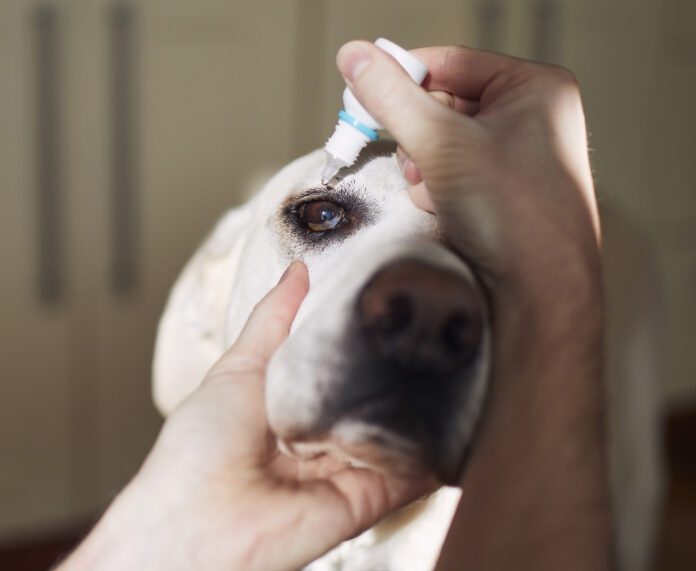Using over-the counter human eye drops for dogs can get you in a lot of trouble. For example, Visine can cause life-threatening problems in your dog (see sidebar), and administering the wrong eye drops for the problem your dog is facing can worsen the condition.
Are Over the Counter Eye Drops Safe for Dogs?
The only safe human eye drops for dogs are saline eye drops and artificial tears. And, even then, you should discuss why you want to use them with your veterinarian before administering the drops. If you just need to flush out your dog’s eyes to remove a crusty discharge, warm tap water will do the trick. Anything else—especially if your dog is showing signs of pain like squinting, redness, or a bloody discharge—needs prompt veterinary attention.
Never use Visine eye drops in dogs! Visine contains active ingredients that constrict blood vessels to “get the red out.” These ingredients are extremely toxic in dogs, potentially causing life-threatening cardiovascular issues, as well as neurologic derangements. Visine is especially toxic if accidentally ingested by the dog. If you have this product in your home, keep it well outside your dog’s reach. If your dog chews up a bottle, call Poison Control and your veterinarian right away.
Prescription Eye Drops
Your veterinarian will prescribe prescription eye drops if your dog suffers from ophthalmic disease. Some drops are the same as human eye drops, so your veterinarian may have you fill your script at your local pharmacy. Drops don’t last as long in the eye and typically must be administered four to six times a day. If this is not possible with your schedule, ask your veterinarian if there is an ointment alternative. Most ointments are administered two to three times daily.
Antibiotic Eye Drops for Dogs
Antibiotic eye drops—triple antibiotic (neomycin/polymyxin/bacitracin), ofloxacin, tobramycin, erythromycin, gentamicin—are prescribed for bacterial conjunctivitis and corneal ulcers. Signs of bacterial conjunctivitis are redness with green or yellow discharge. Corneal ulcer signs include squinting, pain, cloudy cornea.
Steroid Eye Drops
Steroid eye drops like dexamethasone and prednisone are prescribed for allergic conjunctivitis and other inflammatory ocular conditions like uveitis. If you have steroid eye drops in your dog’s medicine cabinet from a prior issue, be aware that steroid drops are not recommended if your dog has a corneal ulcer, as they can delay healing. If your dog is squinting with a painful eye, do not use steroid drops. See your veterinarian as soon as possible.
Other Prescription Eye Drops
Non-steroidal anti-inflammatory (NSAID) eye drops such as diclofenac are frequently prescribed for dogs after cataract surgery.
Cyclosporine and tacrolimus are prescription immunosuppressive eye drops used to treat dry eye syndrome, also known as keratoconjunctivitis sicca (KCS). Signs of KCS in dogs include squinting, ocular irritation, excessive mucous accumulation, and cloudy corneas. Your veterinarian will perform a tear test to confirm the diagnosis before prescribing these drops.
For glaucoma, a disease that causes elevated intraocular (eye) pressure, prescribed eye drops for dogs include dorzolamide, timolol, and latanoprost. Signs of glaucoma in dogs include redness, squinting, pain, cloudy cornea, and an enlarged eyeball. If you suspect your dog may be suffering from glaucoma, seek treatment right away. Uncontrolled glaucoma results in blindness and, ultimately, the loss of the eye.






